|
[ 19 ] Wa47 1chome Tsurugihonmachi Hakusan City Ishikawa Pref.JAPAN |
| PRESIDENT | KOBORI SACHIHO |
|---|---|
| Product Name | SAKE UMESHU |
| Contact | KOBORI SACHIHO |
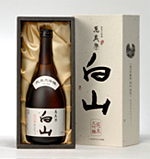 |
Manzairaku Hakusan *Junmai *Daiginjo *Junmai-shu is made from only rice, koji rice (yeast) and water with no extra alcohol added. *Daiginjo-shu More than 50% of the outer part of the rice is scraped off to make Daiginjo-shu. Rice grains are polished to remove at least 50% of their covering to brew Daiginjo-shu. We brew this Junmai Daiginjo-shu from the best quality Yamada Nishiki (rice for sake brewing) by utilizing our facility and technology at Mori-no Ginjo-gura Hakusan (Ginjo-shu brewery in the forest of Hakusan Mountain). It is characterized by its smooth and mellow flavor from Yamada Nishiki sake rice . You can enjoy this item in a sake cup as a matter of course, or you can also enjoy the mellow flavor from a glass. Our Hakusan series include Hakusan Special Junmai, Hakusan Junmai Daiginjo, and Hakusan Daiginjo *Koshu. *Koshu means aged sake although sake is usually enjoyed while fresh. This middle grade item among the series is perfect as a gift because it is nicely packaged. The best quality Yamada Nishiki Yamada Nishiki is called the king of sake rice. It is fit for Ginjo-shu as well as Daiginjo-shu. Hyogo prefecture is a major Yamada Nishiki producing district and has rated the rice paddies producing the very best Yamada Nishiki as a special A district. We purchase Yamada Nishiki grown in a special A-A district, a higher rated district within the special A district. For Hakusan Series we use only Yamada Nishiki grown in Kuchiyokawa, Miki city, Hyogo prefecture. When we purchase this Yamada Nishiki, we make it a point to visit the district and purchase Yamada Nishiki grown in the special A-A district for Hakusan Series. Drinking recommendations/ Enjoy this item chilled (10℃∼15℃) by pouring it into a wine glass. As an aperitif as well as during the meal. Marriage/ It goes well with fresh seafood dishes and vinegar-flavored dishes. -Category: Junmai Daiginjo-shu -Percentage of rice-grain-weight remaining after polishing: 50% -Alcohol content: 15° -Water for brewing: riverbed water of the Tedori River system catchment area -Rice for brewing: Yamada Nishiki -Rice-producing district: Special A-A district, Kuchiyokawa, Hyogo prefecture -SMV sake meter value: +3 -Acid degree: 1.2 -Amino acid degree: 1.3 |
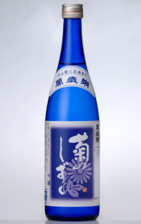 |
Manzairaku *Kiku-no-Shizuku *Ginjo *Kiku-no-Shizuku means dew drops from a chrysanthemum. *Ginjo-shu: More than 40% of the outer part of the rice is scraped off to make Ginjo-shu. This refreshing Ginjo-shu is brewed from good quality Yamada Nishiki and riverbed water from the Tedori River system catchment area. You can enjoy its delicate shades of taste as well as its refined aroma and flavor. -Category: Ginjo-shu -Percentage of rice-grain-weight remaining after polishing: 55% -Alcohol content: 16° -Water for brewing: riverbed water from the Tedori River system catchment area -Rice for brewing: Yamada Nishiki -Rice-producing district: Special A-A district, Kuchiyokawa, Hyogo prefecture -SMV sake meter value: +5 -Acid degree: 1.5 -Amino acid degree: 0.9 |
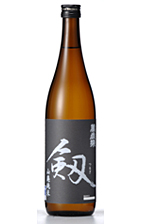 |
Manzairaku Tsurugi Yamahai Junmai This Yamahai Junmai-shu is brewed from late-planted Gohyakumangoku rice produced in Hakusan city, Ishikawa prefecture, where the Manzairaku brewery is based. We take advantage of the strength of late-planted Gohyakumangoku and create a full-bodied taste with well-balanced acidity and umami. Yamahai Junmai-shu can be served either hot or chilled. Its taste will remind you of the serene atmosphere at the foot of Hakusan, White Mountain, through which the Tedori River runs. This item has received confirmation as Hakusan Kiku-zake, a local official name, and received the silver Medal in the Sake Category of the International Wine Challenge 2010. Late-planted Gohyakumangoku Originated in Niigata prefecture, Gohyakumangoku has been produced throughout Japan as rice for sake brewing. The area where Gohyakumangoku is planted is the largest in Japan as it is rather easy to grow and has a high aptitude for sake brewing. For Manzairaku Tsurugi Yamahai Junmai, late-planted and late-harvested Gohyakumangoku is used. The rice is planted about a month later than usual, and it ripens at the end of September to the beginning of October. As the rice ripens in colder months, when the temperature change in a single day can be extreme, the rice is more delicious. However, this process of growing Gohyakumangoku is not typically followed for various reasons - typhoons might damage the ripened crops, harvest per area is smaller, and the farmers cannot work on planting during the consecutive holidays in May. At Manzairaku Corporation, thanks to the president's passion, an experimental Gohyakumangoku late-planting was undertaken. An experimental brewing with late-planted Gohyakumangoku was attempted over three years. During the experimental period, we had the farmers taste the difference between sake brewed from the usual Gohyakumangoku and sake brewed from the late-planted and late-harvested Gohyakumangoku. The results were impressive. Through such a process, we managed to start selling sake brewed from late-planted and late-harvested Gohyakumangoku. Drinking recommendations/ Chilled (10℃∼15℃) Warmed (around 40℃) Marriage/ Fatty yellowtail Bold-flavored simmered winter dishes Grilled fish -Category: Yamahai Junmai-shu -Percentage of rice-grain-weight remaining after polishing: 68% -Alcohol content: 16° -Water for brewing: riverbed water from the Tedori River system catchment area -Rice for brewing: Gohyakumangoku (late-planted and late-harvested) -Rice-producing district: Hakusan city, Ishikawa prefecture -SMV sake meter value: +6 -Acid degree: 1.2 -Amino acid degree: 1.5 |
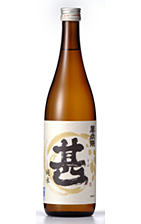 |
Manzairaku Jin Junmai This Junmai-shu is characterized by its unique taste and flavor, which comes from Hokuriku 12, a rare variety of rice. This is authentic local sake, brewed only from Hokuriku 12, produced in Hakusan city, Ishikawa prefecture, and the riverbed water of the Tedori River system catchment area. It is designated as Hakusan *Kikuzake, a local official name. You can enjoy the aroma and flavor of the rice straw minerals as well as the refreshing and mild taste as it glides down the throat. *Kikuzake literally means chrysanthemum sake. Manzairaku Jin Junmai received the Bronze Medal in the Sake (Junmai-shu) Category of the International Wine Challenge 2010. Hokuriku 12 Its nickname is Jinbei-mai Rice. This variety of rice for brewing sake had been widely produced as an excellent variety, ideal for sake brewing in the Hokuriku district until 1960. Sake brewed from this rice tends to have a unique `straw` taste and flavor. Since 1960 Gohyakumangoku has mainly been used for brewing sake instead of Hokuriku 12. Due to the difficulty in harvesting Hokuriku 12, this rice was at risk of becoming endangered. Fortunately, in 1979, Kobori Sake brewery`s 13th -generation president (the current president is the 14th generation) persuaded rice farmers to reestablish harvesting the Hokuriku 12. Since then, rice farmers have continued producing this particular variety by organizing "the Association for producing Hokuriku 12" , and the Kobori Shuzo Sake Brewery purchases their entire harvest to brew our products. Drinking recommendations/ Room temperature (around 20℃) Warmed (around 40℃) Marriage/ Fatty yellowtail Japanese cuisine Western cuisine -Category: Junmai-shu -Percentage of rice-grain-weight remaining after polishing: 68% -Alcohol content: 16° -Water for brewing: riverbed water of the Tedori River system catchment area -Rice for brewing: Hokuriku 12 -Rice-producing district: Hakusan city, Ishikawa prefecture -SMV sake meter value: +6 -Acid degree: 1.9 -Amino acid degree: 1.5 |
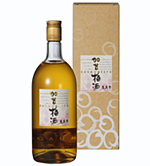 |
Manzairaku *Kaga *Ume-shu *Kaga is the name of the fiefdom of Ishikawa prefecture during the Edo period (1603-1867) *Ume-shu means ume (Japanese apricot) liqueur Manzairaku started brewing this ume liqueur in 1990. It has both a rich taste of ume and a light and refreshing taste as it glides down the throat. We use only Benisashi ume produced in Kanazawa city, Ishikawa prefecture and also in Fukui prefecture. We brew this ume liqueur in a simple traditional manner from unripe green ume, sugar crystals, alcohol and water for brewing. The entire process, from production , to brewing, to bottling the ume-shu, is done in the Hokuriku district , so this ume liqueur is a true Hokuriku product. Achievements Manzairaku Kaga Ume-shu was selected as the best in Japan by the special Saturday column "NIKKEI Plus 1 Ranking" and was served in first class on the All Nippon Airways route to North America and Europe. Benisashi ume *Beni means rouge *Sashi means reflects Benisashi is considered to be a good-quality ume liqueur produced in the Hokuriku district. The name, Benisashi, comes from the rouge on a ripe ume. This contains more amino acid than a typical good-quality ume, called Nankoubai. The increased level of amino acid is why Benisashi has rich umami and mellow taste. This is also used for high-quality umeboshi (pickled ume). This variety is difficult to grow and its harvest is smaller than other varieties because the branches bear fruit only once every three years, Benisashi is a rare species. Drinking recommendations/ On the rocks With water With hot water With soda Cocktail You can enjoy this Ume-shu in a number of delicious ways. -Percentage of alcohol: 14° -Water for brewing: riverbed water of the Tedori River system catchment area -Ingredients: unripe green ume (Benisashi produced in the Hokuriku district) sugar crystals, alcohol for brewing. |
